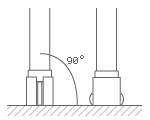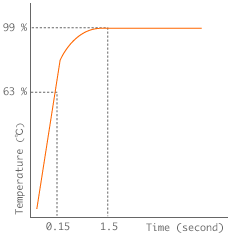Technical Guide
Described below are procedures for ensuring the accuracy, durability, and correct use of your Anritsu Meter temperature measuring product.
Tolerance
The thermocouples used in Anritsu Meter products comply with the Class 2 tolerance standards specified within the Japanese Industrial Standard JIS C1602-1995.
However, since probes structure and other factors can affect the tolerance of specific temperature measuring probes, please refer to the pertinent pages for information on the precision of specific probes.
Thermocouple tolerance
|
Type |
Measuring Temperature |
Tolerance |
|
K |
333 to 1200°C |
±0.75% of measured temperature |
|
-40 to 333°C |
±2.5°C |
|
E |
333 to 900°C |
±0.75% of measured temperature |
|
-40 to 333°C |
±2.5°C |

Probe tolerance measuring conditions
|
specification indicated in catalog |
At 100°C Surface |
At 100°C |
|
Test temperature |
100°C |
100°C |
|
Probe application |
Stationary surface probes |
Internal probes |
|
Moving / rotating surface probes |
Air / gas probes |
|
Test method |
Measurement of stationary metal surface temperatures |
Measurement of boiling water by immersion
Measurement of steam temperatures |
The tolerance of surface probes can vary significantly depending on measuring conditions, measurement target, and the nature of the contact between the probe and measurement target.
When using a probe, make sure the sensor head correctly contacts target surface.
Response time
The response time given for our temperature measuring probes is the time required to detect 99% of the true value.
Probe response time measuring conditions
|
Probe application |
Test method |
|
Stationary Surface Probes |
Measurement of stationary metal surface temperatures |
|
Moving / Rotating Surface Probes |
|
Internal Probes |
Measurement of boiling water by immersion |
|
Air / Gas Probes |
Measurement of steam temperatures |
Response curve
EX) Stationary Surface Probes : A-231K

EX) Internal Probes : BS-21K

Durability
The probe product pages use the following symbols to indicate probe durability.
Note that probe durability can vary significantly depending on actual conditions of use.
Durability rank
|
Durability rank |
Stationary Surface Temperature probes |
Moving / Rotating Surface Temperature probes |
Liquid or Gas Temperature probes |
|
A |
More than 50,000 contacts
(A series : More than 75,000 contacts) |
More than 1500 hours continuously |
Long lived(indefinable) |
|
B |
More than 10,000 contacts |
More than 1000 hours continuously |
More than 1 year |
|
C |
More than 5,000 contacts |
More than 500 hours continuously |
More than 6 months |
|
D |
Less than 5,000 contacts |
Less than 500 hours continuously |
Less than 6 months |
|
S |
Can not evaluate because of special-application |
Stationary Surface Temperature probes
Number of contacts enabling measurement within the accuracy range on a flat and smooth metal surface at a temperature of 300°C(or at the operating temperature limit if the operating temperature limit is below 300°C).
Moving / Rotating Surface Temperature probes
Time period in which measurement was achieved within the accuracy range, on a flat and smooth metal surface moving at a rate of 200 m/min.
Liquid or Gas Temperature probes
When used correctly, virtually no deterioration occurs in these products due to temperature measuring operations.
Therefore, the durability ranking is based on the ease with which impact results in damage.
Operating temperature limit
The operating temperature limit is determined by the allowable temperature limit of the sensor head contacts the measurement target.
Note that the operating temperature limit is not the same as the allowable temperature limits of the grip, cord, and plug.
Note that probes are more easily damaged at temperatures below 0°C, due to frost adhesion, reduced elasticity constant, and other factors.
About products made of polyimide
Some Anritsu Meter products are made of polyimide.
Since polyimide may adversely affect humans, avoid using such products in applications where they may come into contact with food, internal organs, or bodily fluids.
|